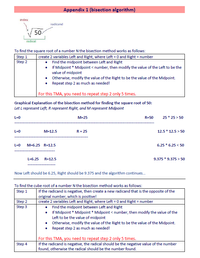
Computer Networking: A Top-Down Approach (7th Edition)
7th Edition
ISBN: 9780133594140
Author: James Kurose, Keith Ross
Publisher: PEARSON
expand_more
expand_more
format_list_bulleted
Question
Please solve using the given method.

Transcribed Image Text:Appendix 1 (bisection algorithm)
index
radicand
50
radical
To find the square root of a number N the bisection method works as follows:
Step 1
create 2 variables Left and Right, where Left = 0 and Right = number
Step 2
Find the midpoint between Left and Right
If Midpoint * Midpoint < number, then modify the value of the Left to be the
value of midpoint
Otherwise, modify the value of the Right to be the value of the Midpoint.
Repeat step 2 as much as needed!
For this TMA, you need to repeat step 2 only 5 times.
Graphical Explanation of the bisection method for finding the square root of 50:
Let L represent Left, R represent Right, and M represent Midpoint
L=0
M=25
R=50
25 * 25 > 50
L=0
M=12.5
R= 25
12.5 * 12.5 > 50
L=0
M=6.25 R=12.5
6.25 * 6.25 < 50
L=6.25
R=12.5
9.375 * 9.375 > 50
Now Left should be 6.25, Right should be 9.375 and the algorithm continues.
To find the cube root of a number N the bisection method works as follows:
If the radicand is negative, then create a new radicand that is the opposite of the
original number, which is positive!
create 2 variables Left and Right, where Left = 0 and Right = number
Find the midpoint between Left and Right
Step 1
Step 2
Step 3
If Midpoint * Midpoint * Midpoint < number, then modify the value of the
Left to be the value of midpoint
Otherwise, modify the value of the Right to be the value of the Midpoint.
Repeat step 2 as much as needed!
For this TMA, you need to repeat step 2 only 5 times.
If the radicand is negative, the radical should be the negative value of the number
found, otherwise the radical should be the number found.
Step 4

Transcribed Image Text:Implement a Java method with the identifier "SquareRoot" that takes 1
parameter of type integer and returns a double value that represents the square
root of the parameter. Note: you must implement the square root function
yourself by using the bisection algorithm as explained in Appendix 1 and you
should NOT use any java.lang.Math function.
Implement a Java method with the identifier "CubeRoot" that takes 1 parameter
of type integer and returns a double value that represents the cube root of the
parameter. Note: you must implement the cube root function yourself by using
the bisection algorithm as explained in Appendix 1 and you should NOT use any
java.lang.Math function.
2.2
2.3
Expert Solution
This question has been solved!
Explore an expertly crafted, step-by-step solution for a thorough understanding of key concepts.
This is a popular solution
Trending nowThis is a popular solution!
Step by stepSolved in 2 steps

Knowledge Booster
Similar questions
- Using the mid – square method obtain the first five random variables using Z0 = 7182arrow_forwardNewton Method - solve by hand Solve by hand function bellow using Newton method. Repeat 5 times. (5 iterations) f(x) = x°-7.x+4arrow_forwardA field goal kicker makes 4 of 5 extra points during a game. What percent of extra points were made?arrow_forward
Recommended textbooks for you
 Computer Networking: A Top-Down Approach (7th Edi...Computer EngineeringISBN:9780133594140Author:James Kurose, Keith RossPublisher:PEARSON
Computer Networking: A Top-Down Approach (7th Edi...Computer EngineeringISBN:9780133594140Author:James Kurose, Keith RossPublisher:PEARSON Computer Organization and Design MIPS Edition, Fi...Computer EngineeringISBN:9780124077263Author:David A. Patterson, John L. HennessyPublisher:Elsevier Science
Computer Organization and Design MIPS Edition, Fi...Computer EngineeringISBN:9780124077263Author:David A. Patterson, John L. HennessyPublisher:Elsevier Science Network+ Guide to Networks (MindTap Course List)Computer EngineeringISBN:9781337569330Author:Jill West, Tamara Dean, Jean AndrewsPublisher:Cengage Learning
Network+ Guide to Networks (MindTap Course List)Computer EngineeringISBN:9781337569330Author:Jill West, Tamara Dean, Jean AndrewsPublisher:Cengage Learning Concepts of Database ManagementComputer EngineeringISBN:9781337093422Author:Joy L. Starks, Philip J. Pratt, Mary Z. LastPublisher:Cengage Learning
Concepts of Database ManagementComputer EngineeringISBN:9781337093422Author:Joy L. Starks, Philip J. Pratt, Mary Z. LastPublisher:Cengage Learning Prelude to ProgrammingComputer EngineeringISBN:9780133750423Author:VENIT, StewartPublisher:Pearson Education
Prelude to ProgrammingComputer EngineeringISBN:9780133750423Author:VENIT, StewartPublisher:Pearson Education Sc Business Data Communications and Networking, T...Computer EngineeringISBN:9781119368830Author:FITZGERALDPublisher:WILEY
Sc Business Data Communications and Networking, T...Computer EngineeringISBN:9781119368830Author:FITZGERALDPublisher:WILEY

Computer Networking: A Top-Down Approach (7th Edi...
Computer Engineering
ISBN:9780133594140
Author:James Kurose, Keith Ross
Publisher:PEARSON

Computer Organization and Design MIPS Edition, Fi...
Computer Engineering
ISBN:9780124077263
Author:David A. Patterson, John L. Hennessy
Publisher:Elsevier Science

Network+ Guide to Networks (MindTap Course List)
Computer Engineering
ISBN:9781337569330
Author:Jill West, Tamara Dean, Jean Andrews
Publisher:Cengage Learning

Concepts of Database Management
Computer Engineering
ISBN:9781337093422
Author:Joy L. Starks, Philip J. Pratt, Mary Z. Last
Publisher:Cengage Learning

Prelude to Programming
Computer Engineering
ISBN:9780133750423
Author:VENIT, Stewart
Publisher:Pearson Education

Sc Business Data Communications and Networking, T...
Computer Engineering
ISBN:9781119368830
Author:FITZGERALD
Publisher:WILEY